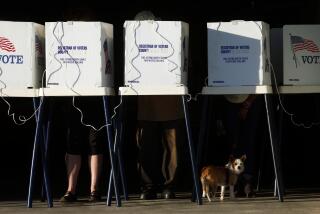High-Tech Riverside Voting in Spotlight
- Share via
RIVERSIDE — Even as a pioneering electronic voting system in Riverside County drew criticism Wednesday from minority activists, it attracted new interest following ballot-box confusion in Florida that has left the presidential race in limbo.
“Suddenly, there is so much interest” in paperless elections, said county Registrar of Voters Mischelle Townsend, who reported a barrage of calls and e-mails from elections officials and congressional aides interested in making elections faster and more airtight.
Riverside County on Tuesday became the first in California to abandon the paper ballot in favor of an electronic system that requires voters to cast their votes by touching a computer screen--similar to a bank’s automated teller machine.
Other areas of the country, including Los Angeles and Las Vegas, have experimented with high-tech voting methods. But Tuesday’s election marked the largest application yet of electronic balloting in the nation--and it was seen in many camps as a harbinger of the future.
There was already widespread interest in the new system before the election, because many officials expect to introduce similar technology in coming years.
Townsend played host to elections officials from across Southern California, including representatives from Orange, San Bernardino and San Diego counties, as well as a delegation from Japan. Government officials in Ireland didn’t make the trip, but are monitoring Riverside County’s progress from afar.
Townsend reported that election day went off with only minor technical problems. And she said the benefits of the new system, which is designed to streamline and protect the election process, were evident immediately.
For example, tabulating votes on the new system is easier and quicker than counting paper ballots because votes are recorded electronically on cartridges, which are then read by computers.
By 10 p.m. Tuesday, Townsend said, 75% percent of Riverside County’s ballots had been counted. Just 23% had been counted by the same hour during the presidential primary in March, the last conducted with paper ballots. “We were so pleased with it,” Townsend said.
But the presidential election in Florida, where officials were scrambling to recount votes after George W. Bush clung to a minute lead over Al Gore, only increased the attention on Wednesday.
“The complexity of our current voting system, and the difficulty of using it, has never been too visible--until now,” said Peter Cosgrove, president and chief executive of Sequoia Pacific Voting Equipment Inc., which made Riverside County’s voting machines. The company is one of about a dozen offering high-tech voting systems in the United States.
Not everyone is ready to move wholesale into electronic ballots, however.
Ingrid Gonzales, the registrar of voters in adjacent San Bernardino County, sees electronic balloting for people who wish to cast their ballots early, or who want to vote absentee. But she said the machines are still too expensive--Riverside County paid more than $13 million for its--to use in the general election.
“We’re probably all going to learn a whole lot from all of this,” she said. “I’m happy to be learning it from a distance.”
What’s more, even as Tuesday’s election stirred renewed interest in the voting system, it also prompted criticism.
Beyond worries about possible fraud, the most vehement protests have come from minority activists who believe the system could intimidate voters who have less access to computers.
“We are increasingly concerned” by the prospect of computerized voting, said Antonio Gonzalez, president of the Los Angeles-based Willie Velasquez Institute, a Latino think tank and research organization.
He said white election officials cannot understand cultural differences that mark the Latino electorate.
For example, Oregon now casts its ballots by mail--but Latinos, Gonzalez said, do not trust the mail for important documents, and often pay their telephone and utility bills in person rather than mailing in a check. He said he fears the same type of barrier could exist when Latinos, who make up a third of Riverside County’s population, are faced with electronic ballots.
While he could not offer any hard data, Matt Barreto, a research associate at the Tomas Rivera Policy Institute, said anecdotal evidence collected so far suggests that as many as 10% of Latino voters in Riverside County will not be back at the polls next time because they are spooked by the electronic system.
“There is a lot of computer illiteracy in the Latino community,” Gonzalez said. “People don’t trust these things--and that’s a problem.”
More to Read
Get the L.A. Times Politics newsletter
Deeply reported insights into legislation, politics and policy from Sacramento, Washington and beyond. In your inbox three times per week.
You may occasionally receive promotional content from the Los Angeles Times.











